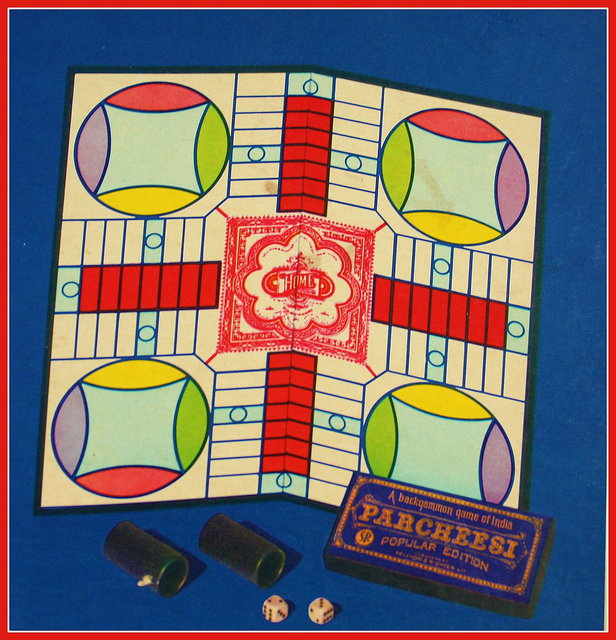<p>The board game Parcheesi is the American version of the Indian game Pachisi, which is the national board game of India. The name Pachisi means twenty-five, as that is the highest number you can throw with the cowry shells used as dice. It is known as a &#8220;cross and circle&#8221; game, as the board is composed of perpendicular columns with a circle at their intersection. Four players start in their own designated area with four pawns each. The first player to circle the board with all four pawns and return back home wins the game. The commercial American version differs significantly from the original Indian game. Variations of the game are played all over the world using different names, such as Ludo or Patchesi in the United Kingdom, Twenty-Five in the Middle East, Parchis in Spain and Parques in Columbia.</p>
<p>The Origins of Parcheesi</p>
<p>The Indian game Pachisi is thought to have originated on the subcontinent around the fourth century AD, having evolved from an earlier game called Chaupar. This game may have originated much earlier, as it is mentioned in the classic epic <i>Mahabharata</i>, which was written sometime between 500 and 300 BC. In a sixth or seventh century depiction of Lord Shiva and the goddess Parvati, some say they are playing Chaupar, though this is not clear. However, the sixteenth century emperor Akbar definitely played the game. The huge life-sized boards in his palace gardens at Fatehpur Sikri, Agra and Allahabad on which he used 16 young harem slaves as game pieces still exist today.</p>
<p>The International History of Parcheesi</p>
<p>The first British version of the game, called Patchesi, was produced around 1860 by the firm of Jaques and Son. In 1896 or thereabouts, the British simplified it to become a children&#8217;s game which they called Ludo. The game reached Germany in the late 1800s, where it became known as Der Weg zur Herberge, or &#8220;The Way to the Inn.&#8221; Around 1900, the French gave the game a horseracing theme, calling it Petits Chevaut, or &#8220;Little Horses.&#8221;</p>
<p>Parcheesi in America</p>
<p>In 1867, an American named John Hamilton brought the game to the United States. He registered and copyrighted the game, using the name Patcheesi. In 1870, he sold the rights to a New York game company which became known as Selchow and Righter. In 1874, they trademarked it as Parcheesi, making it one of the oldest trademarked games in America. For decades it was subtitled &#8220;Royal Game of India.&#8221; Though Selchow and Righter had endured for 119 years and was the oldest family-owned game company in America, in 1986 Coleco Industries purchased Selchow and Righter. In 1989, when Coleco declared bankruptcy, the toy company Hasbro purchased its assets, including the game Parcheesi. As a result, Hasbro is the only company allowed to use the name Parcheesi, but other companies market the game under other names such as Aggravation, Sorry, Trouble, Frustration, India and Headache. Parcheesi remained the bestselling board game in America until 1935, when Parker Brothers released Monopoly, and it continues to sell well and be enjoyed by millions.</p>
<p><i>In addition to Parcheesi, Jonathan M. Harmon writes on magic the gathering cards, Star Wars lore, Star Trek conventions, movie trivia, strategy games, video games and other kindred topics.</i></p>
<p><i>Image credit goes to Calsidyrose.</i></p>

The Gaming Legacy of Parcheesi
